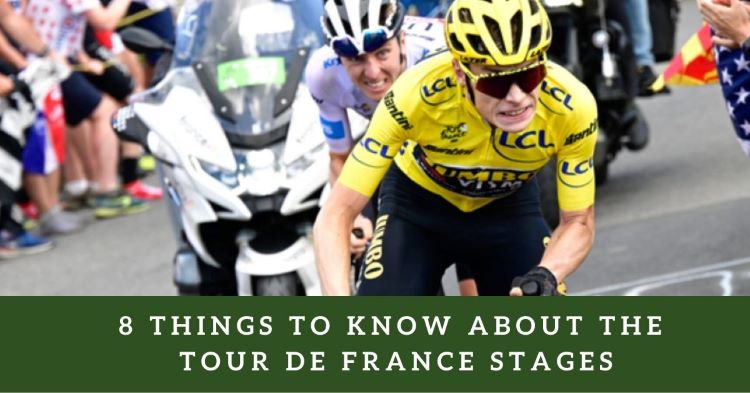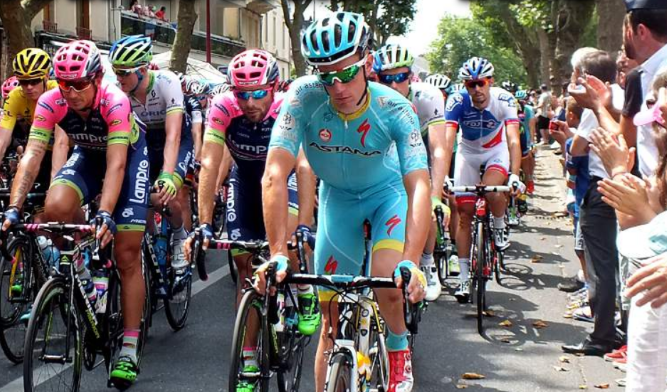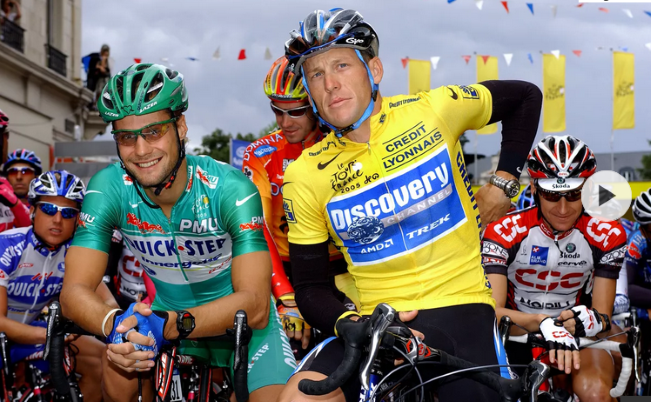Last Updated on February 5, 2024 by Emmanuel

The Tour de France includes twenty-one stages, lasting three weeks for approximately 3,500 kilometers; riders fairly compete each to win the yellow or other jerseys.
Some stages have flat courses on which sprinters feel better; others have short or long climbs requiring much endurance.
Thus, we feel compelled to share eight things about the Tour De France Stages; they will help you learn more about this most prestigious racing.
Table of Contents
From Where Does The Tour de France Start?
The Tour de France can start anywhere in France or the surrounding countries; it depends on the organizers, who change the routes yearly.
Organizers typically choose the starting place specifically for commercial purposes to sustain the race in the long run.
Let’s compare the Tour de France 2021 and 2022 by briefly examining their main stages and routes.
The Tour de France 2021 stages and routes.
This Tour started in Brussels, the European Union capital city, where Eddy Merckx sealed his first victory in 1969.
After two stages in Belgium, the Tour continued in France, and the cyclists faced different challenges.
The route in the north of France was from Reims, the Champagne region, to Nancy for the fourth stage.
Other stages saw the cyclists go through the Vosges, one of the French’s least-cycled mountain areas.
Also, riders warmed their legs in Alsace before they climbed the Côte des Trois and the Planche of beautiful girls.
As usual, this edition of the Tour de France ended in Paris, and Egan Bernal was the first Columbian to win it.
The Stages and Routes of the Tour de France 2022.
The 2022 tour was more international than the previous ones because it went through four countries, starting in Denmark.
After three racing days in this country, the fourth stage continued in Dunkirk, France’s northern city.
The particularity of Dunkirk City is its flat and gently hilly land, making it easier for cyclists to compete.
After that, some stages went through Switzerland and Belgium and continued through France.
Most stages in France, barring the last, passed in hilly and steep areas, including the Ardennes and the Planche des Belles Filles.
Cyclists also faced the traditional challenges of the Alps before the Rhone Valley, the west hills up to Saint Etienne, etc.
Take Away :
The Tour de France has no unique starting point because the organizers change them yearly.
Spectators and fans from different regions of France and other European countries can see their favorite teams when the routes change.

Why Do the Tour De France Stages Start Late in the Day?
Riders spend a day cycling as fast as possible while facing various dangers.
Racers must rest and prepare for the next day’s competition at the end of each stage.
Besides, it is difficult for team managers to find accommodation near the stage departure points.
It results in riders sometimes traveling long distances from the hotels to the stage start.
When riders arrive at that place, they must warm up before they start the stage.
RELATED: Are cyclists in the Tour de France still doping?
Why Have the Stages of the Tour de France Neutralized Starts?
- Why Have the Stages of the Tour de France Neutralized Starts?
- Neutral starts enable riders to warm up and prepare before starting the race.
- Given that there are too many, the lack of neutral starts can favor those in front who can take advantage to escape quickly to the detriment of others.
- Their lack can also make the back riders spend more energy catching the breakaways from the beginning, which is unfair.
To summarize, neutral starts allow participants to ride at roughly the same speed at the beginning of the stage while supporting staff’s vehicles prepare to follow and assist their cyclists.
You can also check why many consider the Tour de France their favorite global sporting event.
Who Won the Tour De France Without Winning Any Stage?
Please check the table below to learn about riders who won the Tour De France without winning a stage; it happened despite being unbelievable.
| YEAR | RIDER | ORIGIN COUNTRY |
| 2019 | Egan Bernal | Columbia |
| 2017 | Chriss Froome | Great Britain |
| 2007 | Oscar Pereiro | Spain |
| 1990 | Greg Lemond | The United States |
| 1966 | Lucien Aimar | France |
| 1960 | Gastome Nencini | Italie |
| 1956 | Roger Walkowiak | France |
| 1922 | Firmin Lambot | Belgium |
Why Is the Last Stage of the Tour de France Ceremonial?
The 21st stage of the TdF comprises the loops around Paris to the Champs Elysées.
During this last stage, riders don’t dispute the top place because the winner is known from the previous one.
The last TdF stage is also short, and it can be challenging for the riders to fill in the gap time between them.
It has always been like that, as this stage allows the riders to show up in Paris through several laps around the Champs Elysees.
You will notice the breakaways, but it is primarily a way for the riders to celebrate their happiness to finish the race.
At this stage, the yellow jersey wearer drinks champagne and poses with his teammates as part of the celebration, which is lovely to watch.

How Are Tour de France Bikes Better than Basic Bikes?
Unlike what many might think, riders use similar bikes on the Tour de France and other like other road bikes for the following reasons:
- Teams remove the quality grease between plates and rollers in these bikes’ chains.
- To make the chain suitable for the race, they soak them in melted paraffin, making them unusable in the long run.
- These bikes are specifically designed for racing rides, not versatile or rugged.
Therefore, the bikes used in the TdF and other popular racing events suit that purpose.
They excel for racing events but are not versatile for other uses you may wish.
That’s what this is discussing: eight things to know about the Tour de France stages can tell; we hope it is worth it.
RELATED: How has the Tour de France changed since it started in 1903?
The Tour De France Stages Final Thoughts.
That’s what we can say about the eight things you should know about the Tour de France stages; hoping that this information is valuable.
Many globally like this world-famous cycling race, and understanding each stage’s ins and outs enables you to appreciate it more.
Leave a Reply